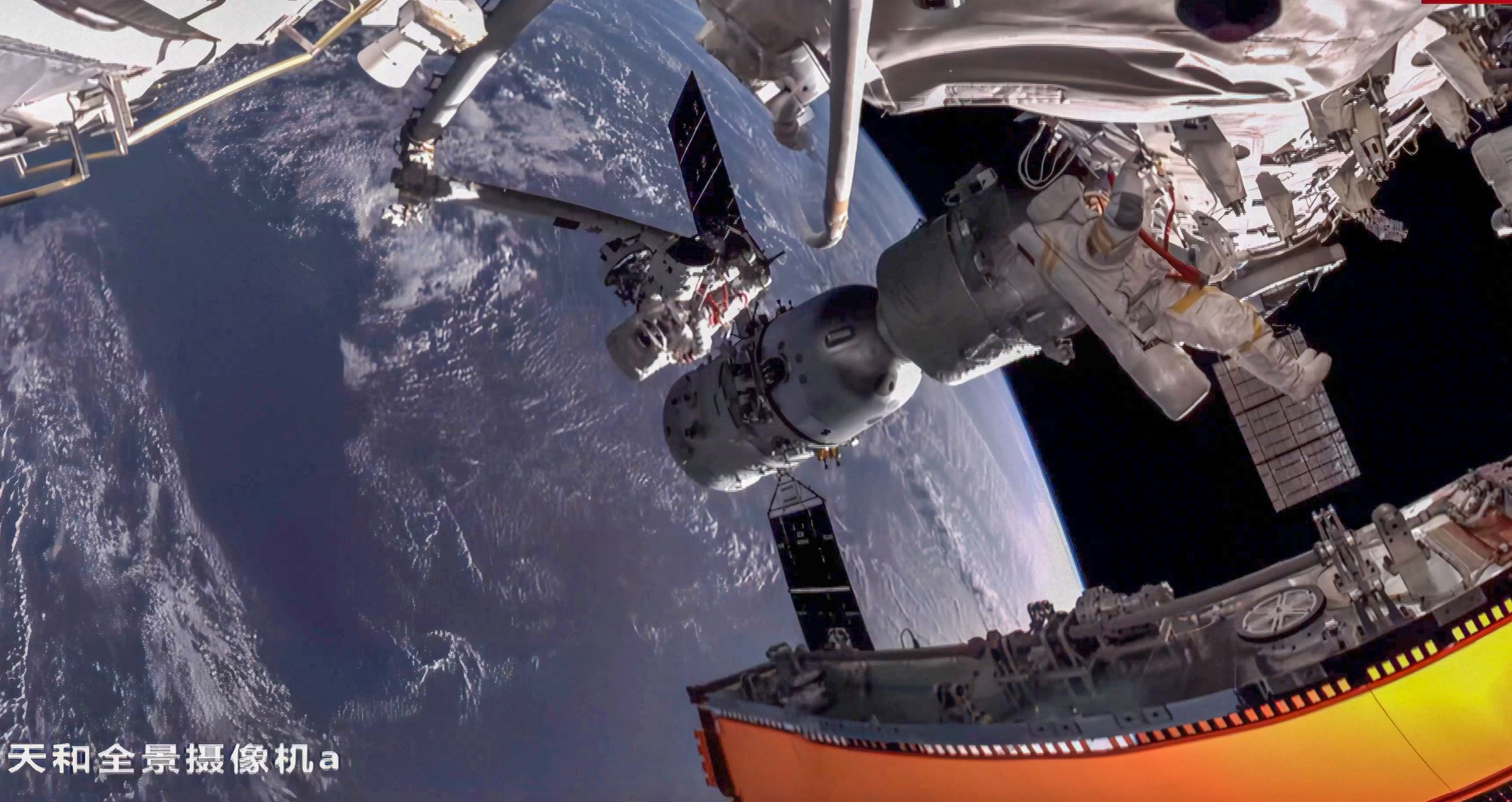HELSINKI — China has informed the United Nations that its crewed space station twice maneuvered to avoid potential collisions with SpaceX Starlink satellites earlier this year.
A notification dated Dec. 6 by China under Article V of the Outer Space Treaty stated that the Tianhe space station module conducted preventive collision avoidance due to close approaches by the Starlink-1095 (2020-001BK) and Starlink-2305 (2021-024N) satellites on July 1 and Oct. 21 respectively.
Starlink satellites typically orbit at around 550 kilometers above the surface of the Earth, but the pair had lowered their altitudes, apparently as part of active deorbiting maneuvers at the end of the satellites’ life.
This saw the pair drift into the path of China’s Tianhe, the first module for the country’s space station. Both times Tianhe was inhabited, by the three-person crew of the Shenzhou-12 mission in July, and the ongoing Shenzhou-13 mission during the October close approach.
Satellite tracker Jonathan McDowell, of the Harvard-Smithsonian Center for Astrophysics, confirmed the two close approaches and avoidance burns using data published by U.S. space tracking. The October pass appears to have been within three kilometers.
I confirmed the Starlink/Chinese Space Station conjunctions on Jul 1 at 1315 UTC (S-1095) and Oct 21 at 2200 UTC (S-2305), with CSS orbit adjustmets at about 0950 UTC Jul 1 and 0316 UTC Oct 21. The Oct passes shown here: pic.twitter.com/DmbIucpRPF
— Jonathan McDowell (@planet4589) December 28, 2021
The note from China requested the UN secretary-general to remind others that, “States Parties to the Treaty shall bear international responsibility for national activities in outer space, including the moon and other celestial bodies, whether such activities are carried on by governmental agencies or by non-governmental entities, and for assuring that national activities are carried out in conformity with the provisions set forth in the present Treaty.”
McDowell told SpaceNews via email that the “A/AC.105 UN series is usually ‘we did this, watch out,’ not ‘we are unhappy someone else did this,’ making this complaint very unusual.
“I expect people will go ‘um, you know the ISS had to dodge debris from the Chinese ASAT more than once too?’ But I think this is another sign we are in a qualitatively new era where the crowding of low Earth orbit is concerned,” McDowell noted.
SpaceX has so far not responded to a request for comment on the incident.
The company has launched nearly 1,950 Starlink satellites, of which about 1,800 are in orbit and providing internet services. SpaceX has plans for 12,000 satellites already approved by the U.S. Federal Communications Commission and has submitted paperwork for 30,000 more across a range of altitudes.
Reuters reported that Chinese internet users have heavily criticized Elon Musk over the incident, following Chinese media reporting on the maneuvers.
Global Times, a Beijing-based tabloid known for nationalistic screeds, cited a Chinese aerospace commentator Dec. 27, suggesting SpaceX possibly “aimed to test China’s sensibility in space” with the two close approaches.t
SpaceX’s Starlink project has been challenged and criticized, by competitors, astronomers, and others, with one industry official saying, “they don’t play well with others.”
The 22-metric-ton, 16.6-meter-long, and 4.2-meter-diameter Tianhe launched in April this year as the first of three modules to form the Tiangong space station. Two Tianzhou cargo spacecraft and the Shenzhou-13 spacecraft are currently docked with the module.
A Long March 2F and Shenzhou-14 spacecraft are in a state of near-readiness at the Jiuquan launch center in the Gobi Desert in case of emergency. Such a launch should be nine days according to reports.
China’s human spaceflight agency (CMSA), the Beijing Aerospace Flight Control Center (BACC), and the China Aerospace Science and Technology Corp. (CASC), have been working to establish the space station and adjust to the challenges of and gaining experience in operating long-term crewed missions in LEO, including cargo supply, spacewalks, and maintenance.
Being able to avoid debris requires being able to detect, track and predict courses of objects in low Earth orbit and be able to maneuver a spacecraft accordingly.
The International Space Station has been required to adjust its orbit to avoid debris numerous times, including due to fragments from a 2007 Chinese military destructive anti-satellite missile test—the largest debris-creating incident to date—as well as rocket upper stages from other countries.
In a further tweet, McDowell suggests the Starlink satellite involved in the July 1 encounter may have performed an avoidance burn, but communication may not have occurred.
A 2019 incident in which an ESA spacecraft dodged a Starlink satellite had earlier highlighted the need for coordination between satellite operators.
“It’s now gone beyond a question of whether we should trust their algorithms or not: with the highest percentage of operational LEO satellites now being owned and operated by Starlink, we have no choice but to trust their algorithms,” said Christopher Newman, professor of space law and policy at Northumbria University in the United Kingdom. “That causes real problems for governance when space diplomacy depends largely upon transparency.”
Low Earth orbit is becoming increasingly crowded, raising the risk of collisions. The growing debris problem threatens space infrastructure upon which many aspects of everyday life now depend.
Debris removal spacecraft and missions are in development, as are technologies and practices for reducing risk. Starlink is far from the only constellation that poses new challenges, however.
Other companies such as OneWeb and countries including China are also planning LEO megaconstellations. Earlier this year China created a company to manage the construction of a 13,000-satellite constellation for LEO communications.
China has so far not commented on a Nov. 15 Russia ASAT test which created debris that threatened the ISS. China’s foreign ministry spokesperson Zhao Lijian said in a Nov. 16 press conference that, “We noted relevant reports and that Russia has yet to respond. I think it is too early to make any comment.”
